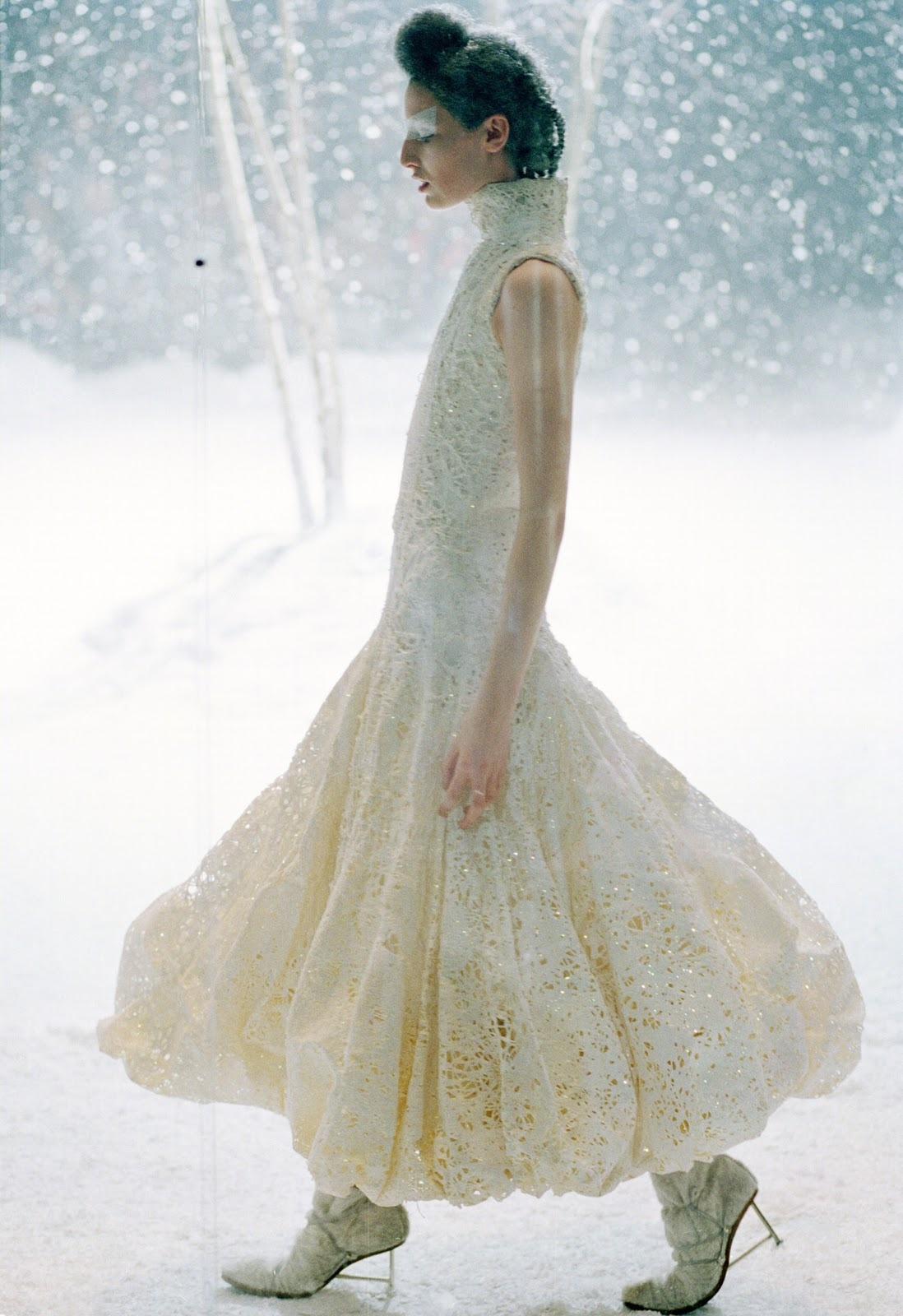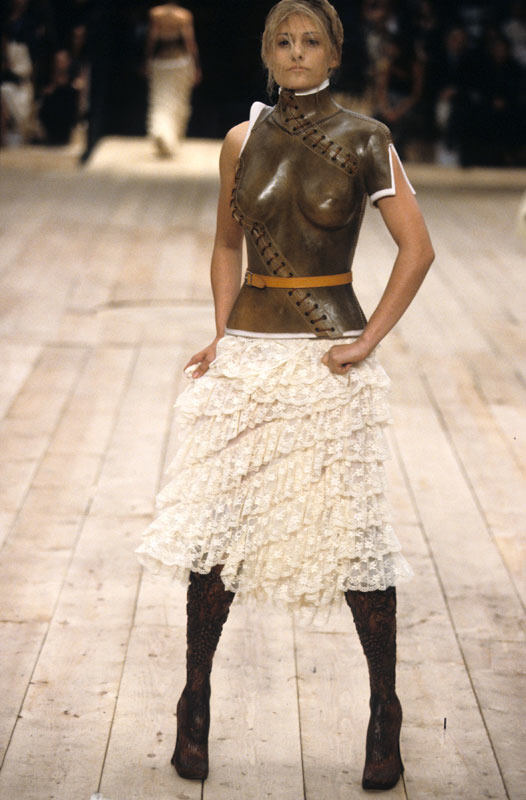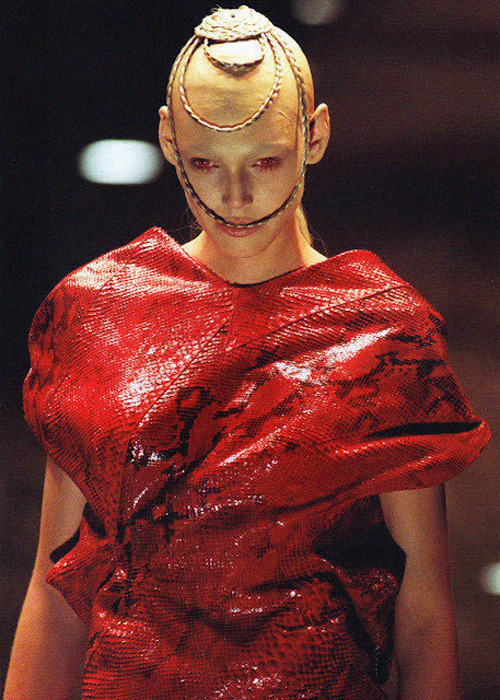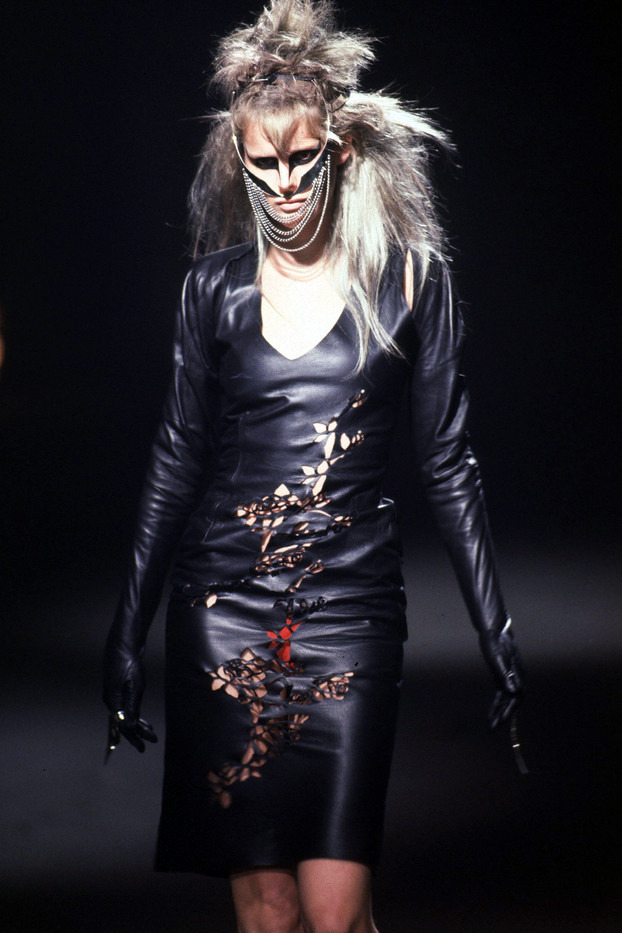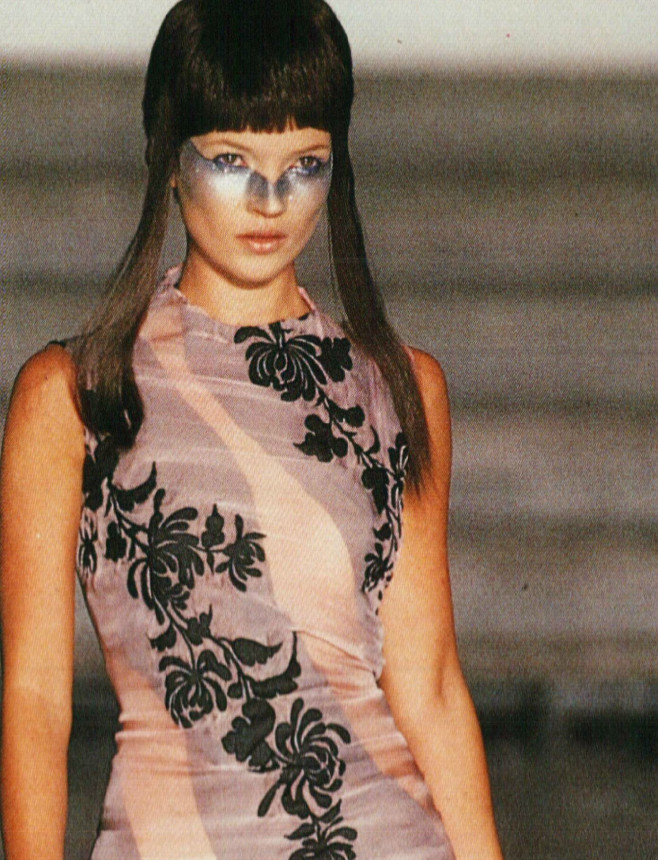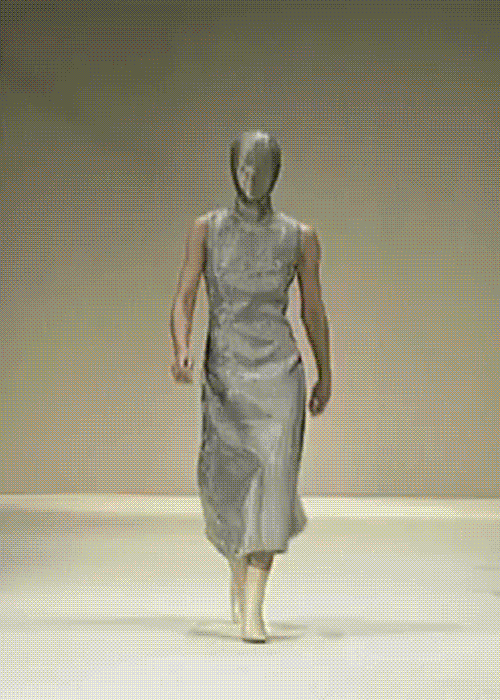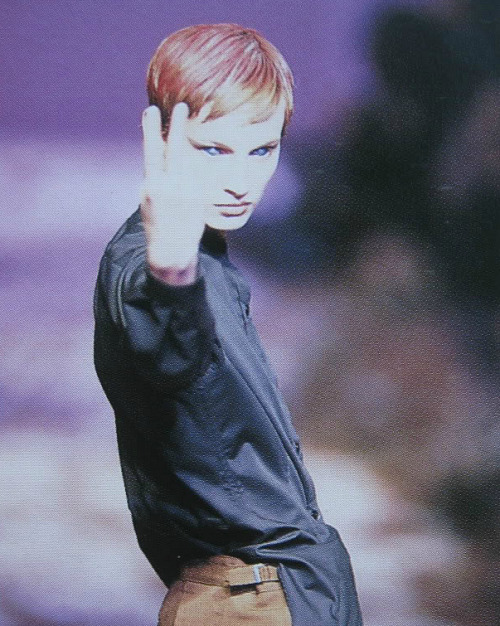Continuing his reign of success, McQueen once
again turned his attention to the film industry to source inspiration for his
A/W 1999 collection ‘The Overlook’ (which can be seen in full here). Named
after the hotel in Stanley Kubrick’s horror classic ‘The Shining’, the show was
full of references to the spooky film – most notably, the staging was an almost
exact replica of one particular scene in which the protagonists flee the hotel
and end up trapped outside surrounded by mountains of snow. Encased in a giant
glass box, models recreated the scene perfectly as they walked around a frozen
ice rink that resided directly in the middle of the runway, creating a winter
wonderland that marks one of McQueen’s most impressive sets to date.
Thursday, 28 November 2013
Monday, 25 November 2013
NO. 13
After revisiting the past with his ‘Joan’
collection, McQueen moved swiftly towards the future with his next collection,
entitled No. 13 (see the full thing here). The show was one of his most
expensive to date, staged on a sprawling runway which featured revolving
platforms built into the floor, as well as two ominous-looking automatic paint
machines which took centre stage. Taking the codes of the McQueen aesthetic and
reinventing them appeared to be the designer’s main prerogative – there were
plenty of looks which were pulled from the archive and reimagined, bringing
them firmly into the future.
The ‘future’ element of the aesthetic came
primarily down to fabric choice. Metallic silver was ubiquitous throughout much
of the collection, and McQueen also experimented with what appeared to be
several mirrorballs that had been pulled apart and fashioned into a halterneck
bodice which jutted forward dramatically, barely covering the model beneath it.
The classic full-length tux jacket was recreated in reflective silver material
and covered in thick black pinstripes, whereas the chainmail dress from Joan (a
short gown with a plunging backline) saw its silhouette replicated exactly in
the same futuristic fabric.
Sunday, 24 November 2013
JOAN
In the world of fashion, it isn’t unusual for
designers to base an entire collection on one influential woman. It also isn’t
unusual for designers to source inspiration from history. However, it is more unusual
for a designer to manage to successfully tell a story with their collection but
with his A/W 1998 collection ‘Joan’ (see in full here), Alexander McQueen achieved just that. Speaking
in an interview, the designer explained “I don’t really get inspired by
specific women, it’s more in the minds of women in the past. People where were
doomed, Joan of Arc or Colette. Iconic women."
The make-up for the show itself was extremely
severe, and loosely based on McQueen’s own make-up for a photoshoot with Nick
Knight for the iconic ‘The Face’ magazine. Eyebrows were shaved, eyes were fitted
with blood-red contact lenses and heads were shaved and decorated with a
succession of intricate braids which wrapped around skulls and led into a
cascade of flowing blonde hair. The two opening looks matched the severity of
the make-up – both were engineered in chain mail and whilst the first was a
short look with a plunging backline, the second was a classic full-length gown
that elegantly swept along the sparse runway. The aggressive chain mail
material marked the beginning of Joan’s story, representing the armour that she
wore as a military leader.
THE GOLDEN SHOWER
Generating controversy before it even took
place, McQueen’s S/S 1998 collection ‘Untitled’ (previously entitled ‘The
Golden Shower’ until a financial backer threatened to pull out - see the full show here) was shown in a
London bus depot and featured then-rookie models such as Jodie Kidd and Kate.
The show has since become one of his most celebrated, mainly for its balance of
commercial appeal and grandiose spectacle but also for launching the career of ‘The
Body’ herself, Gisele.
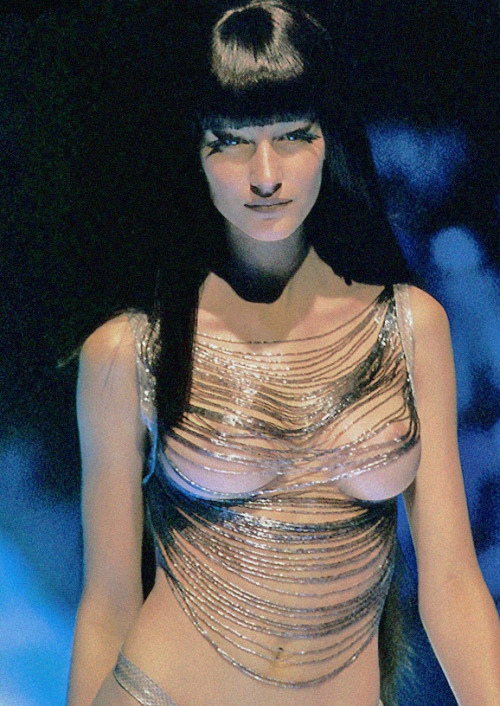 |
| Gisele, The Golden Shower. |
The show opened in traditional fashion with a
series of beautifully-tailored trousers and suit jackets which nipped in at the
waist and curved around the chest. It was here that the McQueen established one
of the main colour themes of the collection – yellow and gold were both
prominent throughout (a reference to the ‘Golden Shower’ title), most notably
in a series of gold chain halter tops that more closely resembled body
jewellery than an actual garment. There was also experimentation with animal
print (one which McQueen had tackled in his previous collection) in the form of
a snakeskin pencil skirt made from what appeared to be PVC, a piece which was
surprisingly wearable when teamed with a black pinstripe suit jacket that
jutted open at the back.
Saturday, 23 November 2013
IT'S A JUNGLE OUT THERE
With its corrugated iron backdrop and thumping
techno soundtrack, “It’s A Jungle Out
There” (which can be seen in full here) is possibly McQueen’s most industrial collection to date. It is
interesting that when giving interviews on the collection, the designer stated
that the mood of the show was based on the Thompson’s gazelle – elaborating, he
explained that “it’s got these dark eyes,
the white and black with the tan markings on the side, the horns – but it is
the food chain of Africa. As soon as it’s born, it’s dead. You’re lucky if it
lasts a few months, and that’s how I see human life; in the same way. You know,
we can all be discarded quite easily. You’re there, you’re gone – it’s a jungle
out there".
Friday, 22 November 2013
LA POUPEE
McQueen continued his
streak of success with his S/S 1997 collection, La Poupée (which can be seen in full here) – a collection inspired by the work of twisted German
puppeteer Hans Bellmer, renowned for his freaky female mannequins who were
often contorted or deformed. Considering that Bellmer’s work was designed to
oppose Nazi definitions of beauty, the fact that McQueen was inspired by the
artist seems natural; both tend to work within the realm of the grotesque and
the mutated, and both take pleasure in rebellion.
Staying true to his signature showmanship, the
designer crafted an extraordinary set which featured a flight of steps leading
down to a flooded runway. The models all had blunt fringes cut to highlight
cheekbones which were almost artificial in their severity, whilst their eyes
were surrounded by bold sweeps of metallic silver eyeshadow. Many of the girls
also wore heavy facial jewellery in the form of protruding spikes or silver
cylinders which orbited the face, whereas the African model Debra Shaw created
the most memorable imagery of the show by attempting to walk the runway whilst
shackled with metal body jewellery. As usual the press rushed to create
controversy, stating that a black woman in chains had to represent slavery – as
usual the press were wrong, and McQueen chose the outfit because he liked the
delicate way that it made the model walk, somewhere between demented and
beautiful.
DANTE
Part of me feels like I should apologise (this is, after all, my second McQueen post in the past four days), but I recently got McQueen's Savage Beauty book and feel like, only being 20, I only really got into fashion a few years ago and there are so many incredible collections that this book has made me aware of. As with all the best McQueen collections Dante contains a strong concept, historicism, several references to religious iconography and, of course, beautiful clothes. Based on the conflict between Heaven and Hell, the collection represents the divine contrast by using white lace,intricate florals and lilac silk to juxtapose black leather and bleached denim. Although the two ideas are usually presented as separate looks, one of the highlights of the show saw a delicate lace top which extended to completely cover the models face, half of which was gripped by a skeletal claw, adding the classic McQueen reference to the grotesque. As the show progressed McQueen's representations of the dark side continued to become more and more literal until one model walked the runway covered head-to-toe in a black lace veil which, when strewn over a pair of reindeer antlers, created a striking portrayal of the animalistic nature of "Dante".
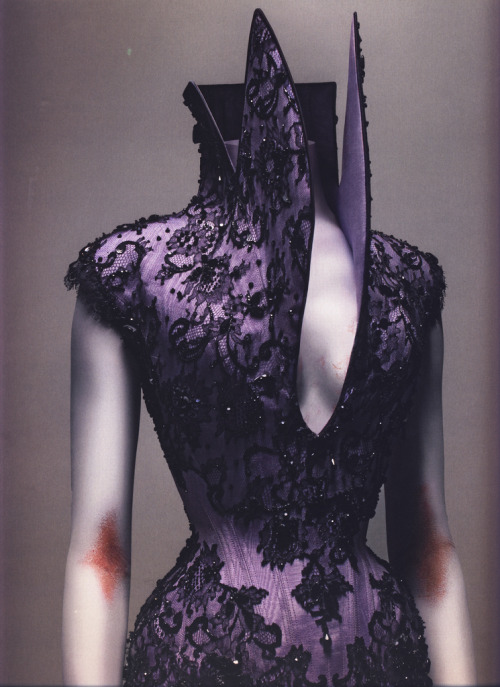 |
| Lace corset used in Dante, shown at the Savage Beauty exhibition |
THE HUNGER
After the controversy surrounding ‘Highland Rape’,
McQueen decided to move towards a less relatable concept for his following
collection, ‘The Hunger’ (which can be seen in full here). The overarching
inspiration for this collection was vampires – the inspiration arguably extends
to macabre imagery in general but the collection seemed more about vampires
than anything else as it focused on the fetishisation of the body, the hunger
for flesh. Many argued that McQueen was already rehashing old ideas, and it is
true that nudity wasn’t exactly new ground for the designer, but the approach
to the nudity was different – it showed the naked body in an almost cannibalistic
way, and there was a kind of perversion and aggression to the way that the
models flaunted their skin, unlike the vulnerable, threatened girls that we saw
in ‘Highland Rape’.
HIGHLAND RAPE
McQueen has always been a designer whose concepts
and imagery have courted media controversy. Sometimes (especially with the
provocative imagery at the start of his career) this controversy is deliberate
but this A/W 1995 collection, entitled ‘Highland Rape’ (see the full show here), is possibly the best
example of McQueen’s vision being misinterpreted and sensationalised by the
media. Upon seeing the collection, journalists clambered over each other to be
the first to denounce the designer as a ‘misogynist’ – an insensitive idiot
glorifying rape to gain media coverage. The backlash was enormous, and it was
only when the designer began to give interviews on the collection’s real
meaning that the press began to thaw. The collection was not a testament to
rape – instead it was a visual commentary on England’s violation of Scotland.
Wednesday, 20 November 2013
THE BIRDS
McQueen’s S/S 1995 collection, ‘The Birds’ is arguably one of his most underrated – there are few pictures of the collection available online and the video of the full show is near impossible to find (although I finally did manage to find it here!) The lack of buzz around this collection is mystifying in a way, as it was the first to feature the bird motif that would soon become a signature of McQueen’s macabre aesthetic; it also featured reincarnations of both the painted evening tuxedos and the shrinkwrap dresses, both reimagined in a striking black and white colour palette.
The collection itself was slicker than usual – the colour palette veered between monochrome and flame red with the occasional sprinkle of metallic, and the silhouette and cut of the fabric were both razor-sharp. Models walked the runway with cropped punk hairdos in a multitude of colours with a badass attitude and tyre-prints stamped menacingly on their bare chests; the juxtaposition of delicacy and aggression is one that McQueen knows so well.
Thursday, 14 November 2013
BANSHEE
For his A/W1994 collection (see it in full here),
McQueen decided to look to the ocean for inspiration. Citing Irish folklore, he
described the title of his Banshee collection
as a reference to the wailing song that banshees would sing, and this reference
was particularly evident in the uncharacteristically ethereal opening looks.
The show’s soundtrack began with a wailing song as models walked the runway in
floor-length gowns of organza, with layers that mimicked the waves of the ocean.
Fishnet dresses draped over models that looked like mermaids captured by
fishermen, and the small ruffled edges of one gown looked like tiny sea anemones.
Even the first three minutes weren’t short of controversy – a pregnant skinhead
in a beautiful black gown walked the runway, ‘MCQUEEN’ emblazoned upon her
shaven head, a look which was a nod back to his signature contrast of beauty
and aggression.
 |
| Montage, McQueen A/W1994 |
Then, the mood started
to change. The wailing song was replaced by a thumping techno beat and the
first flashes of crimson marked a shift towards provocation. The first clue
came in the lyrics of the soundtrack (“You
wanna fuck? Let’s go!”), and it soon became apparent that these banshees
were feeling horny. Models walked the runway with a seductive smile, winking
cheekily at the fashion press as they hitched up their skirts to reveal the PVC
undergarments that lay beneath. Shaggy knitwear was fitted with sheer panels
that left nipples exposed and even tailored suits were worn with sheer lace
tops underneath, or (in one case) a tight rubber bodice that left little to the
imagination. It wasn’t just the women that were there to shock either – one sole
male model walked the runway clutching his crotch as his bumsters threatened to
expose him entirely.
NIHILISM
Staged in October 1993, ‘Nihilism’ (which can be streamed in full here) was
Alexander McQueen’s S/S 1994 collection, and his first ‘official’ collection as
a fashion designer. The definition of the world ‘Nihilism’ itself comes from a
philosophical concept – its general philosophical definition is an ‘extreme
form of scepticism that denies all existence’, but it also holds the
psychiatric definition of ‘a delusion, experienced in some mental disorders,
that the world or one’s mind, body, or self does not exist’. This first collection
was an introduction to McQueen’s intelligent, philosophical take on fashion
design; perhaps one of the greatest things about McQueen is that researching
his work always allows a glimpse into the designer’s mindset and interests at
the time.
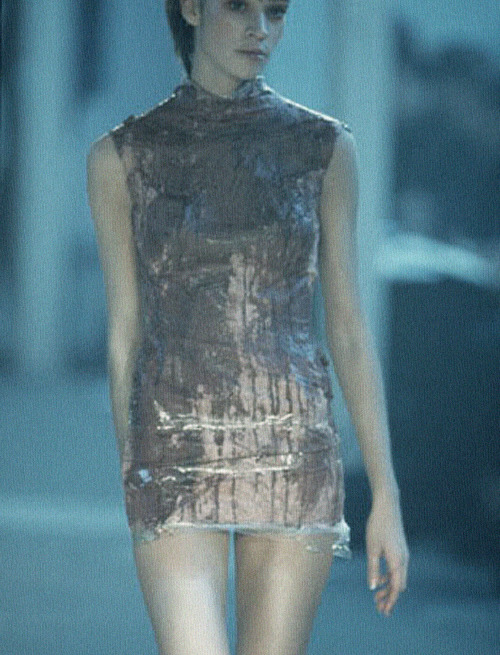 |
| 'Blood-spattered dress', SS1994 |
The concept of Nihilism is visually represented
throughout the collection via translucent fabrics; sheer materials that glide
over the female form, allowing a glimpse at the flesh beneath. The element of
transparency represents that the clothes themselves are nothing – by stripping
the majority of the collection back and showing what were essentially chiffon sheaths,
the clothing itself may as well have no existence as it conceals little to none
of the body itself. Other outfits appeared to be made of cellophane (see above) that had
been wrapped tightly around the body and fitted with a zip in the back –
splattered with rust-coloured paint, the dresses looked like they had been
bleeding; the blood left to congeal. This kind of visual impact is the thing
that McQueen is renowned for; his references to the grotesque and the macabre
immediately set him apart from his contemporaries.
MCQUEEN & I
In these past few months, I have realised that
cultural differences do extend further than clichés, but they definitely do
exist. More than anything, these differences become evident when we look at the
way that the locals dress – in Paris, for example, monochrome is key and the ‘classic’
look is the one that is largely favoured. Well-dressed women keep their outfits
simple and compensate with statement accessories (usually a Chanel bag and a
pair of Louboutins.. even I’m jealous) and dramatic outerwear – fur coats and oversized
capes are amongst the most popular choices. Back in the UK, however, people are more
experimental with their clothing choices – the best example I can think of this
is that the UK have charity shops, whereas they are nowhere to be found over
here. English style is an eclectic mix of colour, print and texture – people aren’t
afraid to be bold with their clothing choices, and with the rise of vintage and
charity shops, young creatives can afford to dress boldly and express their
personality.
 |
| Alexander McQueen for Givenchy Couture |
The reason that I mention this comparison is
that recently I have re-developed a fascination with the late, great Alexander
McQueen – more specifically, I’m fascinated with his brief spell as creative
director of legendary Parisian couture house Givenchy. At this point McQueen
was still in the formative years of his career, and considering his
controversial earlier collections (‘Highland Rape’, ‘Dante’), his appointment
as head of such a classic couture house caused uproar amongst the French
fashion press that immediately slated his debut collection.
Saturday, 9 November 2013
TRANSGENDER x ANDROGYNY
Victoria’s Secret – the two words themselves
have become embellished in modern culture as a synonym for female sexuality.
The legendary underwear brand is no longer just a brand; alongside launching
the careers of supermodels such as Tyra Banks and Adriana Lima, the house hosts
an annual fashion show, a true spectacle that showcases beautiful lingerie and
even more beautiful women. However, Victoria’s Secret has never really courted controversy – until this year. Although not yet confirmed, an online petition has been rapidly gaining popularity and could change the face of fashion forever. The subject of the petition is transgender beauty Carmen Carrera, famous for her stint on RuPaul’s Drag Race [Season 5] and the aim is to bag Carrera a slot in the upcoming fashion show, thus cementing her position as a force to be reckoned with in the modelling world.
 |
| Carmen Carrera |
Friday, 1 November 2013
PORN?
Politics is a tricky business. Within right-wing countries such as my
own home, the United Kingdom, politicians play a difficult game, attempting to
combine conservative values with an economy driven only by growth. Ever since
David Cameron (part of the right-wing Tories) took on the role of Prime
Minister, a class hierarchy of sorts has emerged – arguably an undeniable
element of a Capitalist government and not one which has had a hugely
detrimental effect so far (aside from the fact that most of the population now
shudder with fear at the thought of £9000 tuition fees, meaning that university
education is now less of a right, more of a privilege). However, Cameron’s most
recent announcement that he was going to ‘revolutionise the Internet’ was a
step too far, and a clear example of politics sticking its proverbial nose
where it does not belong.
 |
| Kristen McMenamy, 032c |
The ‘revolution’ of which Cameron speaks will manifest itself in the form of strict online censoring, no doubt designed to appease the overly-sensitive members of the UK population that spend their Saturday nights on the phone to OFCOM, complaining about Lady Gaga getting her arse out on the X Factor. Now, with regards to the ban, it would be less irritating if Cameron was talking about cracking down on child pornography, or if the censorship was aimed specifically at youngsters, but he wasn’t and it isn’t. Instead Cameron now apparently feels he has the right to judge what we, as a nation of consenting, educated adults, should and should not be allowed to see – a rage-inducing thought, especially when we consider the effects that the ban could have on young creatives. This article is designed to highlight just one of the countless flaws in Cameron’s grandiose scheme – the notion of defining what it and what isn’t porn, especially within the realms of fashion and art. In terms of censorship, how can we define what is inappropriate and what isn’t?
Subscribe to:
Posts (Atom)

